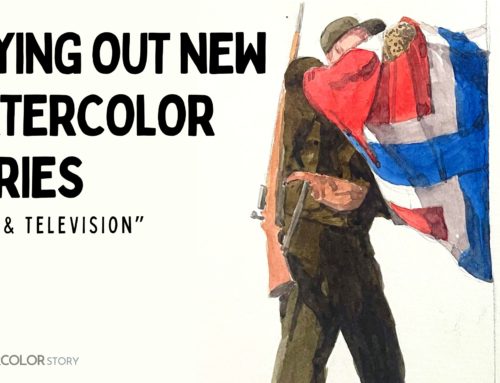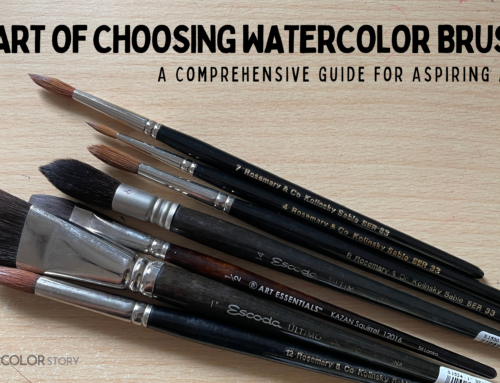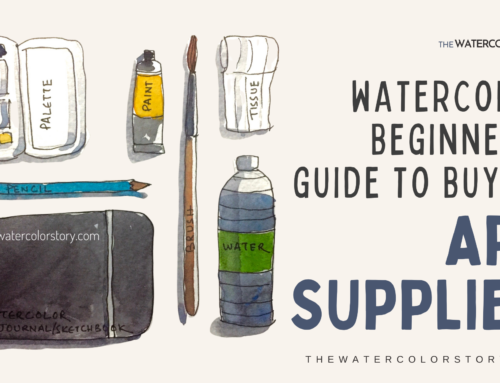
Years back when I started out in Watercolors, it was more or less a lone journey, with no mentor, no critique & no one to say “you are doing this wrong” or “you should do it this way”.
So what happenned is that, I took a lot of time to figure out many things myself through trial and error.
Now when I look back I sometimes think ‘‘I wish there was someone who told me to avoid certain things while starting out in watercolors”. I could have avoided silly mistakes & foolish strategies of learning the medium.
But today when we have internet, as the most easily accessible door to knowledge, we will have so many people advising beginner watercolorists what to do & what not to do.
Here in this article I will mainly focus on a few mistakes that beginner watercolorists do & how to avoid them, so that a smooth learning is achieved mainly focussed on quality knowledge:
1. OVERWORKING
Watercolor is a medium which is loved by artists due to its freshness.
And that freshness comes from keeping the paint strokes & washes to the optimum level. Anything beyond a certain level is termed as “overdoing”. In this case, too much of strokes & too much of washes leaves the work look muddy.
This is not a good sign technically. It is not fresh looking & hence not pleasant.
Now what does that do to the beginner artist? He or She simply gets discouraged.
To overcome this mistake, simply stop worrying about getting the painting perfect. Once you get this in your mind straight, you will know when to stop.
2. OUTLINING THE WASH
While this is a bit debatable, but generally speaking, too much of outlining a wash will simply render the work overworked.
I have seen artists making really good strokes, but then unfortunately taking a un-wanted step of working over it to look “less-fresh”.
Let the paper, paint & water decide how to mingle.
Do not try to give them scientific level precision by outlining the washes.
3. THE MISTAKE OF BEING TOO WORRIED ABOUT MAKING MISTAKES
While starting out in watercolors, we tend to worry a lot about making mistakes.
Don’t worry. You are not alone. Almost everyone does.
While this is not exactly a “mistake’’ that one commits, but it is equally important to get rid of this fear.
You must have heard about “happy mistakes” in Watercolors, which are actually blessings for the painting, in disguise, often leading to beautiful strokes.
If you worry too much, how will you make those “happy mistakes’’?
So, be calm, stop being self-conscious while holding the brush.
You will be surprised pleasantly.
4. DIRECTLY IMITATING
Learning from an artist(be it amateur or professional) is good, but relying too much on their techniques for your painting is not something I would prefer.
You will not know when this turns out to be imitation & later plagarism, both deadly words in the creative world.
Taking reference of a professional artist once in a while for painting is also okay as long as you are giving the source artist credit & most importantly keeping in mind that you don’t own the 100% credit for this work.
This saves you from getting in the quicksand of someone else’s style.
5. USING LOW QUALITY ART SUPPLIES
Many of us would be of the opinion that art supplies don’t have much to do with the quality of a work, but trust me, quality of art supplies that you use will indirectly affect many aspects of your Art.
Quality of art supplies is not only important for longevity of the painting, but also for the confidence that it builds in the budding artist.
A good painting experience comes from good paints, good paper & good brushes. And good painting experience keeps the motivation level high for an artist to keep painting.
6. NOT PRACTICISING DRAWING
Very often, I see beautifully rendered & vivid coloured paintings, but ultimately feel something is missing.
This takes away all the joy that a painting is supposed to bring.
In 99% of these cases, one would easily analyse & conclude that poor drawing is the culprit.
Poor perspective, deformed anatomy, are all results of not giving importance to the fact that drawing is the ABC of any art & no one can make a good painting without proper drawing skills.
In one of my interviews with Thai Watercolorist, Namchai Saensupha, I asked how important is drawing for a watercolor painting & i got a one-liner answer “It is as important as the back-bone to Homo sapiens.”
Bull’s Eye!!
So my suggestion to all artists out there is to cultivate the habit of drawing. This brings exceptional perspective & mind-blowing tonal values in your paintings.
7. TOO WORRIED ABOUT MARKETING
I have seen so many young artists who are just starting out in watercolors & have acquired just beginner level of skills, but pushing themselves so hard to sell their works.
At this phase of being an artists, I would rather prefer to acquire the required skills & then polish them so that, atleast a work that I present for sale is upto the mark & I myself don’t feel ashamed seeing that work after 5 years.
Be patient & keep pushing yourself to practice & once you get a style of your own, market yourself. There is no harm in self-marketing. The only thing I advise you to avoid is actions/decisions that could potentially halt your growth as an artist.
I hope this short post will help you atleast in some way to get your focus on certain important aspects of the learning process, rather than spending your precious time in unwanted experimenting.
Do share your own experience in the comments section.
Happy painting.





[…] 7 mistakes Watercolor beginners make […]